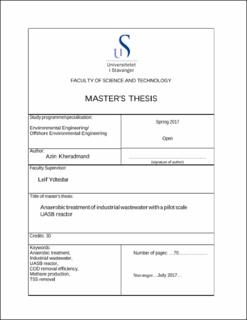| dc.contributor.advisor | Ydtesbø, Leif | |
| dc.contributor.author | Kheradmand, Azin | |
| dc.date.accessioned | 2022-12-28T12:42:31Z | |
| dc.date.available | 2022-12-28T12:42:31Z | |
| dc.date.issued | 2017-07-13 | |
| dc.identifier.uri | https://hdl.handle.net/11250/3039656 | |
| dc.description | Master's thesis in Environmental Engineering | nb_NO |
| dc.description.abstract | The focus of this study was to investigate the performance of anaerobic treatment with a UASB pilot reactor for removal of COD in industrial wastewater at ambient temperatures at Grødaland wastewater treatment plant in Rogaland, Norway. The background for the study was the high-energy cost for aeration of industrial wastewater with aerobic treatment in SBR, so pre-treatment with a UASB reactor would reduce the organic load on the SBR and thus save energy and produce biogas. The wastewater had about 1200 mg COD/l and the temperature was between 15°C to 23 °C during the experimental period. The hydraulic retention time (HRT) was between 26 h and 18 h during the four months of testing. The organic loading rate (OLR) varied in the range of 0.5 to 2 g COD/l. d.
The results demonstrate a significant COD removal efficiency of above 50 % on average during the experimental period. In general, by increasing OLR and decreasing HRT, COD removal efficiency increased as well under steady state condition. This indicates the loading was below the maximum capacity and that the increased flowrate may have improved the hydraulic conditions in the reactor. However, the COD removal also increased at constant OLR probably due to the poor characteristics of first granules which were not in the steady state condition in the reactor during two first months of study. At HRT (18 h) with 0.8 g COD/l. d, and 23 °C, COD removal efficiency reached the maximum of above 70% with second types of granules which had more regular shaped granules. Furthermore, the color of effluent and TSS removal clearly reveal that the granular sludge in UASB had good settling properties and that the sludge was retained efficiently.
An anaerobic treatment systems using UASB reactor for treating industrial wastewater represents an applicable and feasible alternative as pre-treatment for SBR units at IVAR Grødaland by reducing the COD load on the SBR, saving energy for aeration and converting the organic load into economically a valuable product as methane. | nb_NO |
| dc.language.iso | eng | nb_NO |
| dc.publisher | University of Stavanger, Norway | nb_NO |
| dc.relation.ispartofseries | Masteroppgave/UIS-TN-IMN/2017; | |
| dc.rights | Attribution-NonCommercial-NoDerivatives 4.0 Internasjonal | * |
| dc.rights.uri | http://creativecommons.org/licenses/by-nc-nd/4.0/deed.no | * |
| dc.subject | anaerobic treatment, | nb_NO |
| dc.subject | industrial wastewater, | nb_NO |
| dc.subject | UASB reactor, | nb_NO |
| dc.subject | COD removal efficiency | nb_NO |
| dc.subject | Methane production | nb_NO |
| dc.subject | TSS removal | nb_NO |
| dc.title | Anaerobic treatment of industrial wastewater with a pilot scale UASB reactor | nb_NO |
| dc.type | Master thesis | nb_NO |

